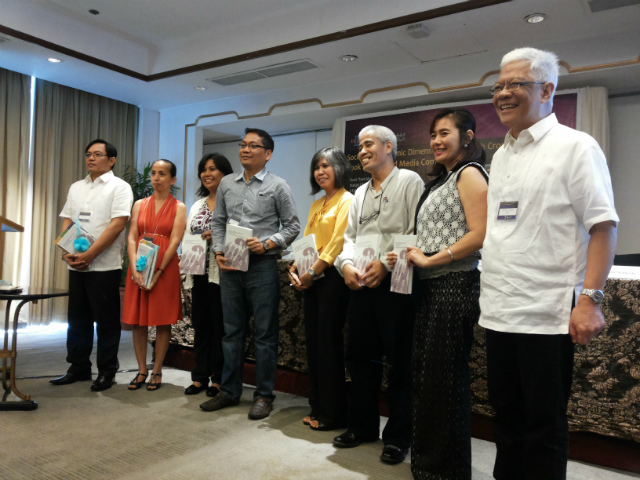Filtered By: Scitech
SciTech
Biotech talong: New book delves into genetic engineering for the eggplant
TEXT and PHOTO by REGINA LAYUG-ROSERO
The humble talong. It doesn’t look like much, but would you believe an eggplant farmer earns more than a professor in a state university?
The profits made from eggplant farming, the safety of a genetically engineered crop, and its effects on poverty and nutrition — all of these are discussed in great detail in a book launched last February 6.
The profits made from eggplant farming, the safety of a genetically engineered crop, and its effects on poverty and nutrition — all of these are discussed in great detail in a book launched last February 6.
Socioeconomic Impacts of "Bt Eggplant: Ex-ante Case Studies in the Philippines" takes a look at this vegetable we take for granted, and tells the story of its reincarnation as a genetically-engineered food.
The book is edited by Roberta V. Gerpacio and Albert P. Aquino. It is published by the International Service for the Acquisition of Agri-biotech Applications (ISAAA) and Southeast Asian Regional Center for Graduate Study and Research in Agriculture (SEARCA), in collaboration with Agricultural Biotechnology Support Project II (ABSPII) and the John Templeton Foundation.
Big money in eggplant
Why make genetically engineered eggplant? What’s so special about this vegetable?
Dr. Cesar Quicoy, Associate Professor at the College of Economics and Management in the University of the Philippines Los Banos, breaks it down into numbers that make sense. Most people don’t know, but eggplant is number one in terms of volume of production for all vegetables in the country. 20 to 25% of eggplant comes from Pangasinan.
Quicoy shared findings from a study conducted in Davao, Iloilo, Leyte and North Cotabato, based on hectarage planted with eggplant. Data was collected from farmer-respondents. That study was just one of the many case studies collected in the book.
At the book launch, Quicoy shared excerpts from the study.
“From 1998 to 2012, the Philippines produced 168,000 metric tons of eggplant, planted on 19,000 hectares of farmland, with an average yield of about 8.5 metric tons per hectare. Average income of farmers on a per hectare basis is about Php 380,000 per cropping season, with a gross margin of about Php 400,000 so that is really a lot of money.”
Quicoy quipped that it was more profitable to go into eggplant production than to be a professor at the University of the Philippines. And further profit could be enjoyed if a mere 15% of eggplant farmers adopted Bt eggplant. Quicoy estimated that within a 10-year period there would be an increase to Php 25-49 million. Per hectare, that’s an expected increase of Php 130,000.
Pesticide in your torta
There’s another plus that Bt eggplant could bring: the elimination of harmful pesticides. Conventional eggplant is often the victim of the fruit and shoot borer (FSB), a “sesame-seed sized moth larva that feeds on eggplant stems and fruits from the inside out,” thus spoiling a significant portion of the yield. Up to 30% of production costs each season are for pesticides.
According to Quicoy, farmers spray crops with pesticide 70 to 80 times per season, much more frequently than recommended, because of the severe pest problem. And in an attempt to maximize the effects of the pesticide, they resort to mixing different chemicals, which researchers referred to as “cocktails.”
In their surveys, researchers had to qualify the questions regarding pesticide use, as some farmers wouldn’t just spray the crops. Instead, the cocktails would be poured out through bamboo tubes, and small children would be made to do this because they are small. If pesticides were to be removed from the picture, production costs would go down by 30%, and you could make tortang talong knowing your family and the small children working in the fields were not exposed to harmful chemicals.

Authors of “Socioeconomic Impacts of Bt Eggplant: Ex-ante Case Studies in the Philippines” with ISAAA's Dr. Randy Hautea at Dusit Thani Hotel, February 6.
It’s in the water, too
A further concern is how the chemical cocktails would trickle through the soil, run off into the water supply, and permeate through the crop. One chapter in the book discusses the impact of insecticide residue on the environment as well as on the health of farmers and consumers, as studied in Sta. Maria, Pangasinan, by Dr. Jinky Leilanie Lu of the National Institution of Health.
In the introduction, Lu explains that because “FSB larvae are internal feeders, control through chemical pesticide is often futile and even presents high risks of environmental degradation and contamination.”
Unfortunately, farmers don’t know that excessive use is unnecessary. They also don’t realize that these pesticides – and the harmful chemicals they contain – remain for weeks after spraying is over. That means these chemicals stay in the environment too, seeping into the different water sources.
One such chemical, dichlorodiphenyltrichloroethane (DDT), is banned by World Health Organization, and is only allowed for use in malaria-infected areas. DDT stays in the environment for 10 years, Lu says. Dermal irritation, respiratory problems, dizziness, inhalation problems, skin cancer and muscular dysfunction are only some of the effects of DDT on human health.
Lu’s only recommendation: reduce, or if possible completely stop, the use of pesticides.
Lu and Quicoy are only two of the authors whose work is featured in this book. Its 10 chapters say a lot about the humble talong, now powered with biotechnology. From market prospects to health and environmental impacts, from poverty and nutrition studies to policy implications, the authors have considered practically every possibility.
And if Bt eggplant ever becomes commercially available, then more Pinoys can perhaps have healthier, better eggplant to eat. — KDM, GMA News
Tags: bttalong, bttalongbook
More Videos
Most Popular



